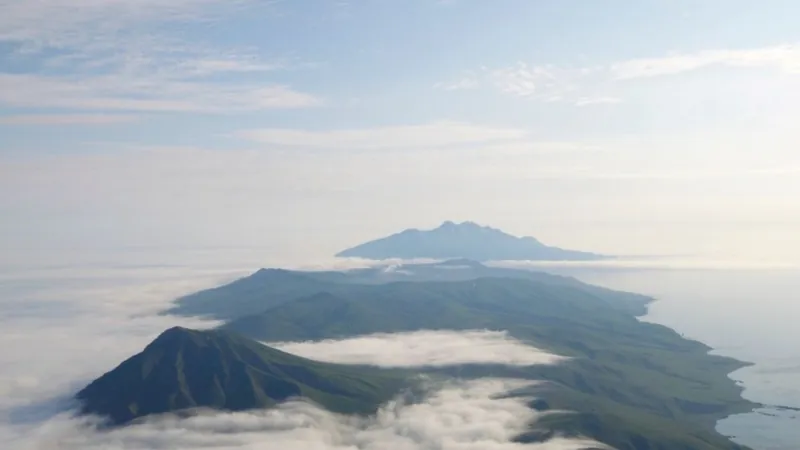
Unveiling the Fiery Secrets: The 1831 Eruption that Colored Our Skies and Cooled the Earth
2025-01-06
Author: Jacques
A Groundbreaking Discovery
A groundbreaking discovery by researchers has traced the origins of a climate-altering volcanic eruption from 200 years ago, revealing that it was this event that resulted in a striking blue hue in the sunlight. The year 1831 witnessed a sharp cooling of the Northern Hemisphere, averaging around 1.8 degrees Fahrenheit (1 degree Celsius), coinciding with reports of bleak weather and the sun appearing in vivid colors.
The Zavaritskii Volcano
Initially, scientists knew that a monumental eruption was the culprit but the specific volcano responsible remained elusive—until recent findings uncovered that the Zavaritskii volcano, located on the isolated Simushir Island in the contested Kuril Islands between Russia and Japan, was the source.
Historical Significance
The historical and scientific significance of this finding published on December 30, 2024, in the journal PNAS underscores the little-known volcanic activity of the Kuril Islands, a region that has been shrouded in mystery largely due to its remoteness. According to William Hutchison, a volcanologist from the University of St Andrews who led the study, “Eighteen thirty-one is a relatively recent period of time, but we had no idea this volcano was responsible [for the dramatic eruption].”
The Little Ice Age
The eruption contributed to the final stages of the Little Ice Age, a period that wasn’t a full ice age but marked the coldest epoch in the last 500 years. Researchers found no direct eyewitness accounts of the 1831 eruption, as the Kuril Islands remain largely uninhabited and cloudy, obscured by the meteorological conditions. However, the eruption's far-reaching effects can be pieced together through literary accounts, such as that of the German composer Felix Mendelssohn, who lamented the “desolate weather” and unseasonable cold as he traversed the Alps.
Striking Colors in the Sky
Reports from that time indicated that the sky exhibited striking colors ranging from blue to green due to the scattering of sunlight through the ash particles propelled into the atmosphere—a phenomenon that would later be famously replicated after the 1883 eruption of Krakatoa.
Impact on Food Supply
The impact of this volcanic activity was severe, possibly contributing to widespread famines in India and Japan during the 1830s. “With large volcanic eruptions like this one, cooling leads to altered rainfall patterns and reduced crop yields,” Hutchison explained, emphasizing the critical food shortages that resulted from such climatic shifts.
Research Methodology
To pinpoint the eruption's origin, Hutchison and his team meticulously analyzed ash remnants in polar ice cores from Greenland. They found a chemical composition that closely matched ash from the Zavaritskii volcano, a moment Hutchison described as an “Eureka-type moment,” resembling the satisfaction of a forensic match in crime investigations. “It was really a terrific day. One of the best days I've ever had in the lab,” he recounted.
Continuing Challenges
Despite uncovering this volcanic mystery, Hutchison lamented that there is a significant gap in monitoring volcanic activity in the Kuril Islands and worldwide. "If a similar eruption were to occur today, our preparedness would not be much improved compared to 1831,” he cautioned, highlighting the continued challenges faced in predicting catastrophic environmental shifts.
Conclusion
This pivotal research sheds new light on the profound influence of volcanic eruptions on climate patterns, emphasizing the intricate connections between our planet's geological activities and atmospheric conditions. As climatic extremes become a growing concern, understanding past events like this eruption could be crucial in preparing for the future.



 Brasil (PT)
Brasil (PT)
 Canada (EN)
Canada (EN)
 Chile (ES)
Chile (ES)
 Česko (CS)
Česko (CS)
 대한민국 (KO)
대한민국 (KO)
 España (ES)
España (ES)
 France (FR)
France (FR)
 Hong Kong (EN)
Hong Kong (EN)
 Italia (IT)
Italia (IT)
 日本 (JA)
日本 (JA)
 Magyarország (HU)
Magyarország (HU)
 Norge (NO)
Norge (NO)
 Polska (PL)
Polska (PL)
 Schweiz (DE)
Schweiz (DE)
 Singapore (EN)
Singapore (EN)
 Sverige (SV)
Sverige (SV)
 Suomi (FI)
Suomi (FI)
 Türkiye (TR)
Türkiye (TR)
 الإمارات العربية المتحدة (AR)
الإمارات العربية المتحدة (AR)